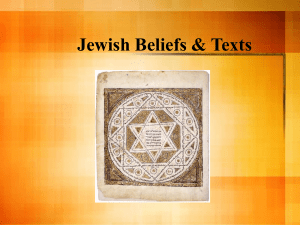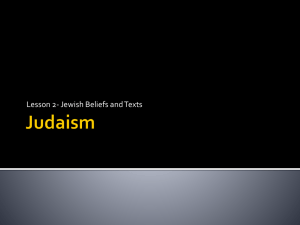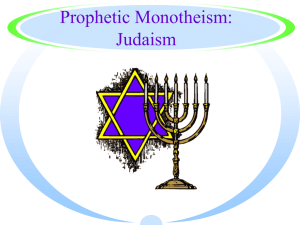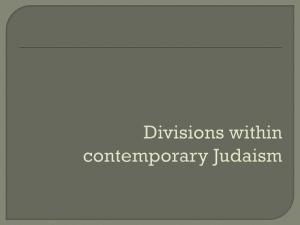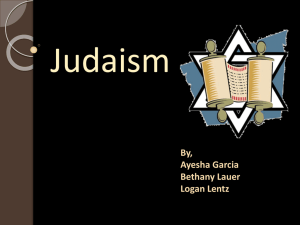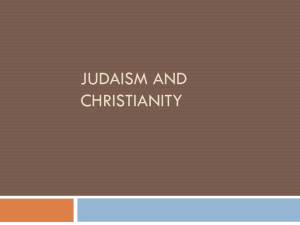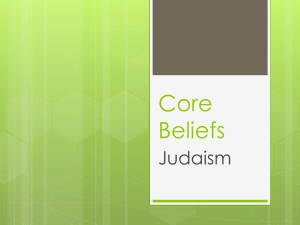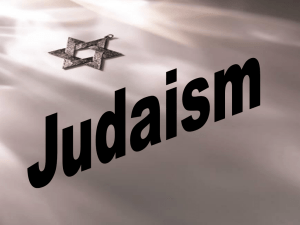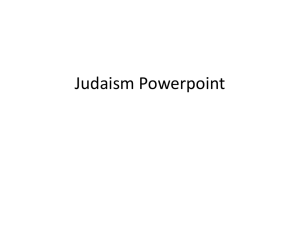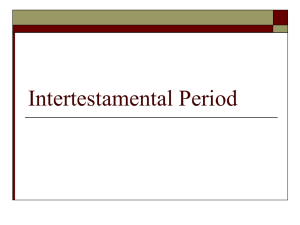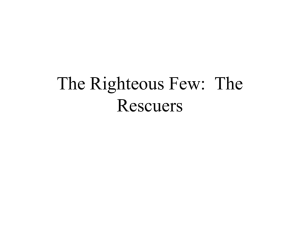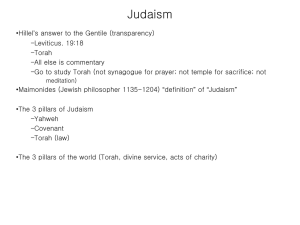Modern Jewish Development - University of Mount Union
advertisement
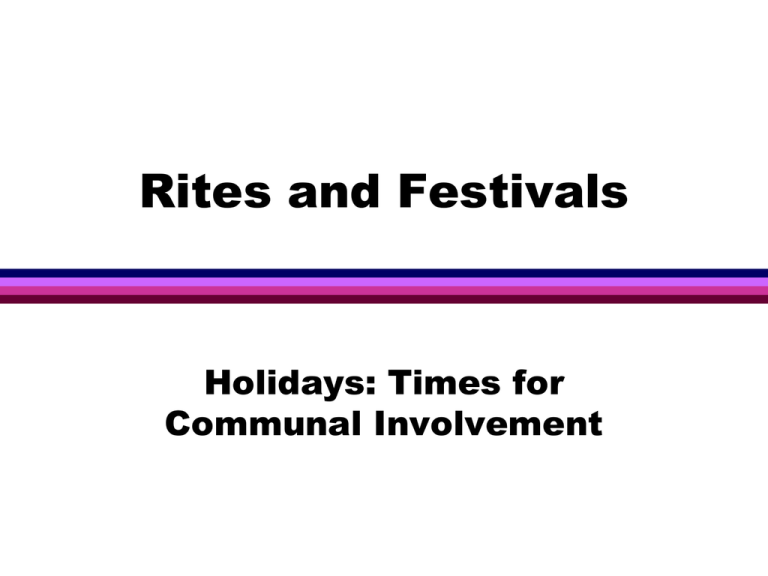
Rites and Festivals Holidays: Times for Communal Involvement Rites Male Circumcision Circumcision of the male child at 8 days. The whole community celebrates. Bar Mitzvah Bar Mitzvah (Bas Mitzvah girl) boy reaches 13 years of age demonstrates acceptance of Covenant Marriage Jewish marriages are very important. Judaism, like many other religions, is matrilineal. Burial For Jews the dead need to be respected and the living need to move on. There are 4 to 5 periods of mourning. Aninut Shivah Shloshim The First Year Keeping Memory Alive Festivals Pesach Pesach (Passover) deliverance from Egypt Shavuot Shavuot (Pentecost) harvest and Torah. Moses received the Torah. Sukkot Sukkot (tabernacles) Fall Festival. This commemorates the Jews wandering in the wilderness. Feast of Purim Purim (deliverance from the Persian Empire). The Queen Esther story. Rosh Hashana Rosh Hashana (New Year) Yom Hakippurim Yom Kippur (Day of Atonement) Hanukkah Hanukkah (victory over the Syrians in 165 BCE) Remembering Yom Hashoa – A time to remember those who died in the Holocaust. Period 2 Part 2 Changes (Period 2 - Part 2) Everything must change Judaism God’s Promise Jewish Beliefs Jewish Belief There is no official Jewish creed-however, there are some basic ideas. • Belief in God. God is one, formless, allknowing, and eternal. God is master of the universe as its creator and judge. God is both loving and just. • Belief in the words of the prophets. Jewish Belief • Belief that God gave the law to Moses. • Belief that the Messiah, the savior to be sent by God, will come some day. • Belief that there will be a resurrection of the good “in the world to come.” Maimonides Moses Maimonides • Born Cordoba, Spain in 1135 • Died Egypt 1204 • One of the greatest Jewish scholars • Extensive work on the commentary on the Torah http://www.jewishjournal.com/opinion/article/survival_hinges_on_being_light_u nto_nations_20080516/ 13 Principles of the Jewish Faith I believe with perfect faith that • God is the creator and Ruler of all things. • that God is one. • God does not have a body. • God is first and last • it is proper to pray to God. • all the words of all of the prophets are true. • the prophecy of Moses is absolutely true. • the entire Torah that we how have is that which was given to Moses. I believe with perfect faith that • this Torah will not be changed, and there will never be another given by God. • God knows all of a man's deeds and thoughts. • God rewards those who keep his commandments, and punishes those who transgress Him. • in the coming of the Messiah. • God that the dead will be brought back to life when God wills it to happen. Changes in notions (Period 2 - Part 2) Although the Messiah is the one who will come was literally expected it is no longer interpreted literally. Along immortality of a literal nature has often been expounded many now emphasize the kind of immortality which comes through one’s offspring, acting virtuously in this world or leaving behind charitable contribution. Notions Humans have a special role because they are created in the image of God and they have the ability to speak, to reason, to will, to create and to care. They have the ability to demonstrate divine characteristics to the world. Divisions within Judaism Divisions within Judaism Cultural Based Observance Based Cultural Based Sephardim Ashkenazim Falashas, Ethiopian Jews Cultural Based Sephardim • These are Jews who lived in medieval Spain until they were expelled in 1492. Those who refused to become Christians moved to North Africa, Italy and Turkey. Cultural Based Ashkenazim • A Yiddishspeaking group of Jews who settled in central and northern Europe. The term in Hebrew referred to Germany. Cultural Based Falashas • These are Ethiopian Jews who continue to practice sacrifices in their temples. Israelis recognized them publicly as Jews by airlifting many of them to Israel. However, some do not think that they have been completely accepted by the some of the Jewish community. Observance Based Orthodox Judaism Conservative Judaism Reform Judaism Reconstructionist Judaism The Four Branches of Judaism Judaism Orthodox Maintain traditional beliefs and practices Reformed Incorporated modern ideas and thinking into religious practices Conservative Make some concessions but maintain certain traditional practices Reconstructionists Individual interpretation Symbolisms, Metaphors Judaism, changing cultural force Orthodox Orthodox Judaism • it came into existence after the Reform began. • A branch of Judaism committed to retaining traditional practice and belief. • They are hesitant about discarding any traditional practices. Orthodox Among the things that they believe are: • In synagogues women are separate from men • There must be a quorum of men for service to begin • Only men celebrate the coming of age (bar mitzvah) Orthodox • Males keep their heads covered • Social roles are strictly separate (trad. Men/Women) • Orthodox household keep strict rules about diet. Conservative Frankel Solomon Schchter was an early leader of this branch. • The Reform movement was too radical. • The Torah and the Talmud must be followed. • Practices can vary from synagogue to synagogue. • Most of the worship service is in Hebrew. Conservative • Males wear head coverings (yarmulkes or kippot) • Members are encouraged to observe kashruth, kosher food laws, Shabbat and holidays. • Change is accepted but with much study and discussion and carefully weighing all traditions. Reform Judaism David Einhorn and Isaac Mayer Wise inspired this movement in the US. • The Torah has moral authority but ceremonial and dietary laws are no longer binding. • A need for a Jewish homeland was recognized. • An emphasis is placed on religious practice, observing the Sabbath, and keeping the holidays. • Most of the services are in English and males are not required to wear coverings. • Men and women can sit together • Women can be ordained as Rabbis. Reform Judaism Reform Judaism advocated religious tolerance, Judaism could be combined with secular culture and embraced many of the ideas of the European Enlightenment. More Reform Reform synagogue has women and men sitting together, services are conducted in both Hebrew and the native tongue, there are choirs and use of organ. Traditional ways of dressing are dropped. The idea is to totally modernize Judaism to be able to survive contemporary cultures. Reconstructionist Judaism Founded by Mordecai Kaplan. Individuals in this form are introduced to traditional Judaism but are allowed to individually interpret elements. Such things as angels, prophecy, revealed law, and the messiah are taken as symbols. God is seen as “the power which makes me follow even higher ideals.” Judaism is seen as a changing cultural force. The Holocaust The Genocide of a People The Holocaust Adolf Hitler as Chancellor of Germany in 1933 began a campaign to remove the Jews from Germany and eventually Europe. He believed that • Jews were an inferior race. • Jews were conspirators against Germany. • Jewish blood poisoned Germany. The Holocaust He identified them and sent most of them to extermination camps where they were subjected to human experimentation among other things. They were divided into two groups--those who were strong enough to work and those who were not. The Holocaust First Hitler forcibly removed the Jews, stole their property and harassed them. Then he systematically destroyed the Jews. The Holocaust The rest were mostly--women, children, the sick and the elderly-were killed immediately. First they used guns but there were too many--they constructed gas chambers and crematoria. The Holocaust By the end of the war about 12 million people were killed and they were Jews, homosexuals, gypsies, Jehovah’s Witnesses, prisoners of war and political enemies. About half of those killed were Jews, approximately 1/3rd of the Jewish population of the world. Zionism Creation of the State of Isreal Zionism Theodore Hertzel was the founder of the movement which advocated a Jewish home country. Creation of the State of Israel Three important steps: • Idea of a separate Jewish state, described in a book entitled The Jewish State. • The Balfour Declaration of 1917 by the British government. • After WWII in part because of the Nazi slaughter of the Jews the United Nations voted to divide the British portion of Palestine for the Jewish State. Sources Slide 3 – http://www.noharmm.org/images/brisisrael.jpg Slide 4 – http://www.wildernessstudio.com/BarMitzvah.html Slide 5 – http://www.wildernessstudio.com/JewishWedding.h tml Slide 8 – http://www.cmo.nl/pe/pe6/pesach.gif Slide 9 – http://www.israelartguide.co.il/yisrael/miryam/5a.jpg Slide 10 – http://www.ahavaschesed.com/images/graphics_suk kot/outside%20sukkot%202000%2002.jpg Slide 11 – http://ddickerson.igc.org/vinnitsaimages/purim-gnivan.gif Sources Slide 12 – http://www.epopp.com/mojopro/cg/images/rosh%20hashana.jpg Slide 13 – http://www.bh.org.il/Images/Virtual_Exh/Photos/16.jpg Slide 14 – http://io.uwinnipeg.ca/~oberle/hanukkah.jpg http://www.cincinnati.com/holidays/img/postcards/hanukk ah.jpg Slide 15 – http://kievershul.tripod.com/holidays.html Slide 27 – http://www.jmcponline.org/graphics/sephardi/faces.jpg Slide 28 – http://www.jmcponline.org/graphics/ashkenazi/faces.jpg Slide 29 – http://www.israel-inside.com/falashas.htm Sources Slide 32 – http://www.peterlanger.com/People/Religion/Judais m/pages/ILJER063.htm Slide 33 – http://www.ou.org/mike/atprayer.jpg Slide 34 – http://i-cias.com/e.o/ill/jud_orth01.jpg Slide 35 – http://www.ucalgary.ca/~elsegal/363_Transp/shecht er.gif Slide 36 – http://www.bethshalomcarrollcounty.org/images/co nservative.gif Slide 37 – http://www.kenesethisrael.org/archive/RabbisSenior/RabbisSenior.htm Sources Slide 38 – http://www.huc.edu/aja/IWise.htm Slide 39 – http://www.ardom.co.il/maayanbmidbar/pic1.jpg Slide 40 – http://uahcpsw.org/Cantor%20Choir%205%20.JPG Slide 41 – http://www.jrf.org/rt/kaplanyoung%20big.gif Slide 42 – http://learn.jtsa.edu/topics/reading/bookexc/gillman_ conservativej/chap5/page75.jpg
